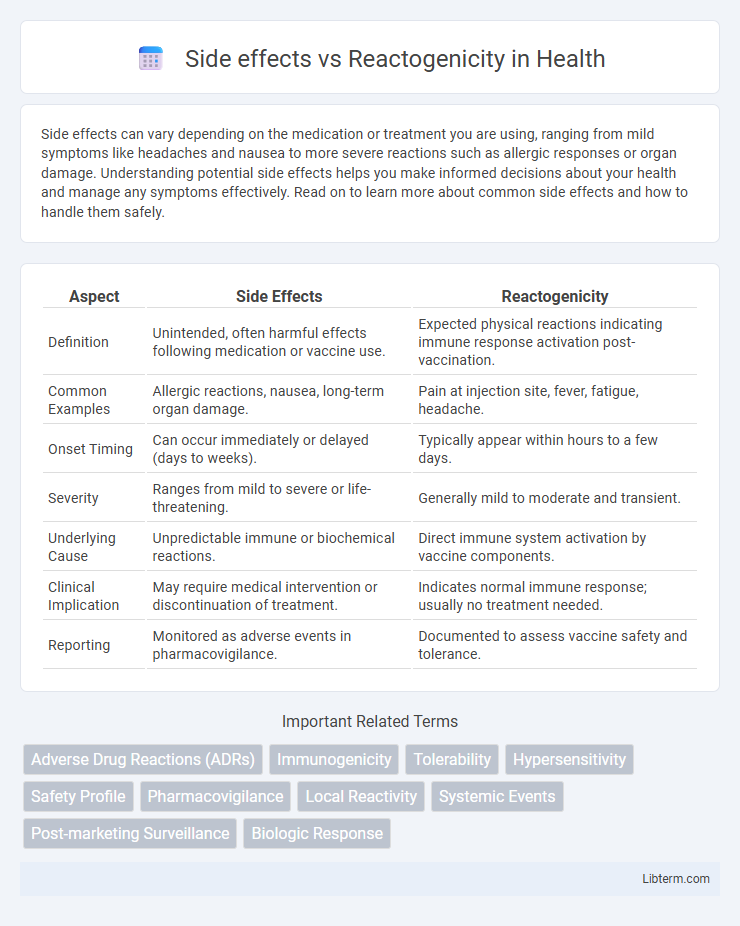Side effects can vary depending on the medication or treatment you are using, ranging from mild symptoms like headaches and nausea to more severe reactions such as allergic responses or organ damage. Understanding potential side effects helps you make informed decisions about your health and manage any symptoms effectively. Read on to learn more about common side effects and how to handle them safely.
Table of Comparison
| Aspect | Side Effects | Reactogenicity |
|---|---|---|
| Definition | Unintended, often harmful effects following medication or vaccine use. | Expected physical reactions indicating immune response activation post-vaccination. |
| Common Examples | Allergic reactions, nausea, long-term organ damage. | Pain at injection site, fever, fatigue, headache. |
| Onset Timing | Can occur immediately or delayed (days to weeks). | Typically appear within hours to a few days. |
| Severity | Ranges from mild to severe or life-threatening. | Generally mild to moderate and transient. |
| Underlying Cause | Unpredictable immune or biochemical reactions. | Direct immune system activation by vaccine components. |
| Clinical Implication | May require medical intervention or discontinuation of treatment. | Indicates normal immune response; usually no treatment needed. |
| Reporting | Monitored as adverse events in pharmacovigilance. | Documented to assess vaccine safety and tolerance. |
Understanding Side Effects and Reactogenicity
Side effects refer to unintended, often adverse reactions following medication or vaccination, varying in severity and duration. Reactogenicity specifically describes the physical manifestations of the immune system's response, such as pain, redness, or fever, typically appearing shortly after vaccination and resolving quickly. Understanding the distinction helps healthcare providers manage patient expectations and improve vaccine safety communication.
Defining Side Effects in Medical Context
Side effects in a medical context refer to unintended, often adverse reactions that occur in response to a drug or vaccine, distinct from the expected physiological reactions classified as reactogenicity. While reactogenicity encompasses transient, predictable immune system responses such as fever or soreness at the injection site, side effects may present as more severe or unexpected symptoms affecting different organ systems. Understanding the distinction between side effects and reactogenicity is critical for clinical assessment, patient counseling, and pharmacovigilance in therapeutic management.
What Is Reactogenicity?
Reactogenicity refers to the physical manifestations of the inflammatory response triggered by vaccines, including common symptoms like pain, swelling, redness at the injection site, fever, and fatigue. These symptoms indicate the immune system's activation and are generally expected and short-lived, distinguishing reactogenicity from more severe side effects that require medical attention. Monitoring reactogenicity helps evaluate vaccine safety and tolerability, guiding improvements in vaccine formulation and administration strategies.
Key Differences Between Side Effects and Reactogenicity
Side effects refer to any unintended and generally adverse reactions occurring after medication or vaccination, ranging from mild to severe symptoms. Reactogenicity is a subset of side effects characterized by the immediate, expected inflammatory responses such as pain, redness, and swelling at the injection site, or systemic symptoms like fever and fatigue. Unlike broad side effects, reactogenicity specifically indicates the body's short-term immune response signaling vaccine efficacy and is usually transient and self-limiting.
Common Examples of Reactogenic Reactions
Reactogenicity refers to the physical manifestations commonly observed after vaccination, such as pain at the injection site, redness, swelling, fever, fatigue, and headache, which are indicative of the immune response in action. These reactions typically resolve within a few days and are considered normal, whereas side effects encompass a broader range of unintended effects that may or may not be immune-related. Common reactogenic reactions serve as early markers of vaccine immunogenicity and are useful for clinicians to anticipate and manage patient expectations.
Typical Side Effects of Vaccines and Medications
Typical side effects of vaccines and medications include mild reactions such as pain at the injection site, fever, fatigue, and headache, which are generally short-lived and resolve spontaneously. Reactogenicity specifically refers to the physical manifestation of the innate immune response triggered by vaccination, often presenting as localized swelling, redness, and systemic symptoms like chills or malaise. Understanding the distinction between general side effects and reactogenicity helps healthcare providers communicate expected reactions and manage patient expectations effectively.
Why Reactogenicity Matters in Clinical Trials
Reactogenicity refers to the physical manifestation of the body's inflammatory response to a vaccine, such as pain at the injection site or fever, which helps predict overall vaccine safety and tolerability in clinical trials. Understanding reactogenicity is crucial because it provides early indicators of immune system engagement and helps researchers distinguish between mild, expected reactions and more serious adverse events. Monitoring reactogenicity enhances the assessment of vaccine risk-benefit profiles, guiding dosage optimization and improving participant adherence in trial phases.
Addressing Patient Concerns About Reactogenicity
Reactogenicity refers to the expected and transient immune responses following vaccination, such as redness, swelling, or mild fever, whereas side effects encompass a broader range of unintended reactions, potentially more severe or long-lasting. Addressing patient concerns about reactogenicity involves educating them that these symptoms indicate the immune system is responding appropriately and typically resolve within a few days. Clear communication about the normalcy and brevity of reactogenicity helps reduce vaccine hesitancy and builds confidence in immunization safety.
Monitoring and Reporting Side Effects vs. Reactogenicity
Monitoring side effects involves systematic collection of adverse events occurring after vaccination, focusing on identifying rare or unexpected reactions. Reactogenicity refers to expected, transient inflammatory responses such as pain, swelling, or fever that arise shortly after immunization, generally resolving without intervention. Effective reporting systems differentiate between benign reactogenicity and serious side effects to ensure accurate vaccine safety surveillance and timely public health responses.
Implications for Public Health Communication
Side effects refer to unintended symptoms occurring after vaccination, while reactogenicity describes the expected physical responses such as fever or soreness that indicate immune activation. Clear differentiation in public health messaging enhances vaccine confidence by setting accurate expectations and reducing anxiety related to normal post-vaccination reactions. Effective communication strategies should emphasize the transient nature of reactogenicity to improve vaccine acceptance and adherence.
Side effects Infographic

 libterm.com
libterm.com